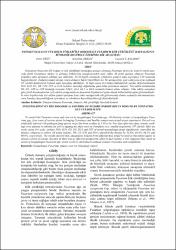| dc.contributor.author | Yiğit, Fahri | |
| dc.contributor.author | Çoban, Keziban | |
| dc.contributor.author | Balaban, Yasemin Y. | |
| dc.date.accessioned | 2020-11-20T17:33:46Z | |
| dc.date.available | 2020-11-20T17:33:46Z | |
| dc.date.issued | 2007 | |
| dc.identifier.issn | 1300-5774 | |
| dc.identifier.uri | https://app.trdizin.gov.tr//makale/TnpVNU9UQXc | |
| dc.identifier.uri | https://hdl.handle.net/20.500.12809/7975 | |
| dc.description.abstract | Domateste Fusarium kök boğazı ve kök çürüklüğü hastalığını patojen olmayan Fusarium türleri ile kontrol etmek ama-cıyla farklı Gramineae türleri ve domates bitkilerinin rizosferlerinden izole edilen 40 farklı patojen olmayan Fusarium izolatları saksı denemesi şeklinde test edilmiştir. Perlit-kepek ortamında yetiştirilen patojen saksı toprağına 1/19 oranında bulaştırılmıştır. İnokulasyondan iki gün sonra domates fidelerinin kökleri her bir antagonistin spor solüsyonu içine (yaklaşık 108 cfu/ml) daldırılarak bulaşık saksı toprağına dikilmiştir. 10 hafta sonra 0-4 skalası kullanılarak yapılan değerlendirmede D18, G39, G5, D8, D23, D25 ve D38 izolatları hastalığı diğerlerine göre daha iyi kontrol etmiştir. Test edilen izolatlardan D8, G5, G39 ve D18 hastalığı sırasıyla %34.6, 46.4, 64.2 ve 69.6 oranında kontrol altına almıştır. Elde edilen sonuçlara göre farklı konukçulardan izole edilen antagonistlerin domateste biyokontrol ajanı olarak kullanılabileceğini göstermektedir. In vitro koşullarında test edilen ajanlar patojene karşı etkin antagonistik etki göstermemiş olması nedeniyle etki mekanizma-sının konukçu dayanıklılığının uyarılması ve rekabetten kaynaklanabileceği düşünülmüştür | en_US |
| dc.description.abstract | To control the Fusarium crown and root rot by nonpathogen Fusarium spp., 40 diversity isolates of nonpathogen Fusa-rium spp., from roots of various plants belonging Gramineae and healthy tomato were tested as pot experiment. Pot soil was artificially infested with pathogen fungi grown on perlite-bran medium at 1/19 (v/v). Two days after inoculum, tomato seedl-ings were planted in infested pot soil by dipping the plant roots at transplant in a conidial suspension (108 cfu/ml). After ten weeks using 0-4 scale, isolates D18, G39, G5, D8, D23 and D25 of tested nonpathogen fungi significantly controlled the disease compared to others. Of tested isolates, D8, G5, G39 and D18 controlled the disease by 34.6%, 46.4%, 64.2% and 69.6%, respectively. The results showed that, antagonists isolated from different host would be used as biocontrol agents in disease control in tomato. Because of there was no effective antagonistic effect in dual culture, it was suggested that, mode of action of nonpathogen Fusarium spp. tested would be attributed to induced systemic resistance and competition. | en_US |
| dc.item-language.iso | tur | en_US |
| dc.item-rights | info:eu-repo/semantics/openAccess | en_US |
| dc.subject | Ziraat Mühendisliği | en_US |
| dc.title | Patojen olmayan fusarium türleri ile domateste Fusarium kök çürüklüğü hastalığının biyolojik kontrolü üzerinde bir araştırma | en_US |
| dc.item-title.alternative | Investigation on the biological control of fusarium root rot in tomato by nonpathogen Fusarium spp. | en_US |
| dc.item-type | article | en_US |
| dc.contributor.department | MÜ, Fethiye Ali Sıtkı Mefharet Koçman Meslek Yüksekokulu, Bitkisel Ve Hayvansal Üretim Bölümü | en_US |
| dc.contributor.institutionauthor | Yiğit, Fahri | |
| dc.contributor.institutionauthor | Çoban, Keziban | |
| dc.contributor.institutionauthor | Balaban, Yasemin Y. | |
| dc.identifier.volume | 21 | en_US |
| dc.identifier.issue | 42 | en_US |
| dc.identifier.startpage | 59 | en_US |
| dc.identifier.endpage | 63 | en_US |
| dc.relation.journal | Selçuk Üniversitesi Ziraat Fakültesi Dergisi (:Selçuk Tarım ve Gıda Bilimleri Dergisi) | en_US |
| dc.relation.publicationcategory | Makale - Ulusal Hakemli Dergi - Kurum Öğretim Eleman | en_US |


















